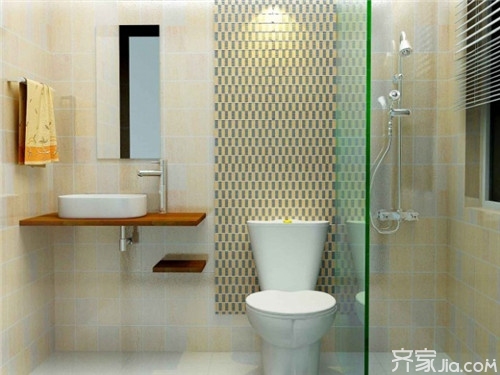Many homeowners do waterproofing of bathroom walls in home renovations, and have insufficient understanding of the waterproof construction standards for toilet walls and the waterproof height of bathroom walls, causing water seepage. Today, Xiao Bian took everyone to look at the bathroom wall waterproof construction specifications and bathroom wall waterproof height for your reference. Bathroom wall waterproof construction specification 1, waterproof construction should be used for coating waterproof material. 2. The performance of waterproof material shall comply with the relevant national standards and shall have a product certificate. 3, the surface of the grass-roots level should be flat, without hollowing, sanding, cracking and other defects. The base layer moisture content should meet the construction requirements for waterproof materials. 4, waterproof layer should extend from the ground to the wall, 250mm above the ground. The height of the waterproof layer on the bathroom wall should not be less than 1800mm. 5, waterproof cement mortar leveling layer and the base combination of dense, no hollowing, the surface smooth and smooth, no cracks, sand, yin and yang angle made of arc-shaped. 6, the coating waterproof layer brushing uniform, thickness to meet the requirements of product specifications, the general thickness of not less than 1.5mm not exposed. 7, the use of construction joints should be connected in the direction of water, lap width of not less than 100mm, the use of more than two layers of glass fiber cloth when the upper and lower overlapping lap width should be one-half. 8, the film surface is not blistering, non-flowing, smooth without bumps, and pipe fittings, sanitary fittings, floor drain, drain joints tightly closed sleek does not leak. 9, the thickness of the protective layer of cement mortar, strength must meet the design requirements, the operation is strictly prohibited damage to the waterproof layer, according to the design requirements to do a good ground flooding slope, drainage should be smooth, there must be no backwater slope phenomenon. Bathroom wall waterproof height 1, wall waterproof height: For the height of the waterproof wall, a waterproof height of 30 cm is generally required. When the wall is not load-bearing, the waterproof height of the entire wall should be at least 1.8 meters. Wall waterproof paint to do about 30cm high, to prevent the accumulation of water infiltration wall surface dampness. The height of the bathroom wall of the shower room is generally 180cm; there is a bathtub, and the height of the wall adjacent to the bathtub should be 30cm higher than the height of the bathtub. 2, waterproof height of the brick wall surface: The installation of floor tiles is an important part of our bathroom's waterproofing. In addition to laying a floor tile, we must make a waterproof layer under the surface. We should use cement mortar to level the floor and apply a waterproof coating. When the waterproof layer of the floor tile is in contact with the wall, it should be upward. From above, about 25~30cm above the ground. The height of the bathroom's sewer's waterproofing is related to our future health problems. Therefore, when handling it, one thing is to prevent the odor in the drainage pipe from overflowing into the interior of the sewer to prevent the sewer from plugging. 3, washbasin, toilet waterproof height: The wall of the bathroom that is in contact with the washbasin is 300mm above the washbasin; if your toilet is not a toilet but a toilet bowl, then it has a waterproof height of 1800mm above the floor. The pipe (including the casing) that passes through the floor in the bathroom shall have a waterproof height of approximately 100 mm from the root of the pipe. Editor's summary: The related information about bathroom wall waterproofing is introduced here for everyone. I hope this article will be helpful to everyone. If you want to know more information, you can pay attention to this website information. Bathroom toilet waterproof
Zinc coating is a type of protective coating that is commonly used on metal surfaces to extend their durability and prevent them from corroding or rusting. It involves the application of a thin layer of zinc onto the surface of metal parts through a number of processes, the most common of which is hot-dip galvanizing.
The benefits of zinc coating are many. It offers excellent corrosion resistance, making it ideal for outdoor applications where metal parts are exposed to harsh weather conditions. Zinc coating also provides a smooth and uniform finish, which enhances the appearance of the metal and makes it more visually appealing. In addition to this, zinc coating improves the overall performance of the metal part by increasing its resistance to wear and tear.
Zinc coating is used in a variety of industries and applications, including construction, automotive, and manufacturing. In the construction industry, it is used to protect steel structures such as bridges, buildings, and pipelines from corrosion. In the automotive industry, it is used to protect metal components such as car frames, exhaust systems, and suspension parts. In the manufacturing industry, it can be used to protect machinery and equipment parts from rust and corrosion.
In conclusion, zinc coating is a highly effective and versatile technology for protecting metal parts from corrosion and rust. Whether for outdoor or indoor applications, it offers numerous benefits in terms of performance and durability. As such, it is an essential process for enhancing the longevity and reliability of metal parts across a range of industries and applications.
Zinc Plating,Cold Galvanizing Spray,Zinc Plated Steel,Zinc Nickel Plating Lizhi Precision Manufacturing Technology Co.,Ltd , https://www.lizhihardware.com

